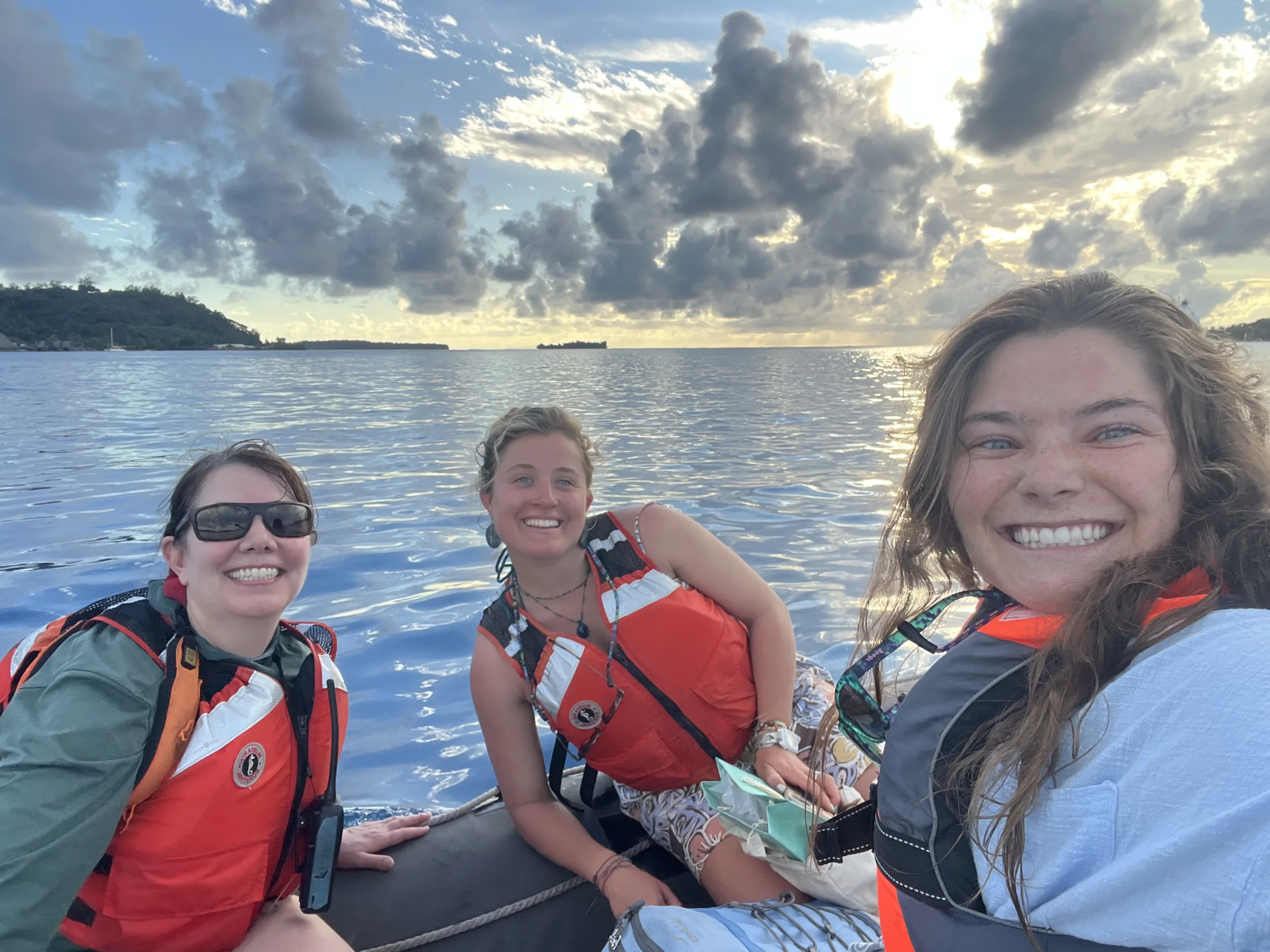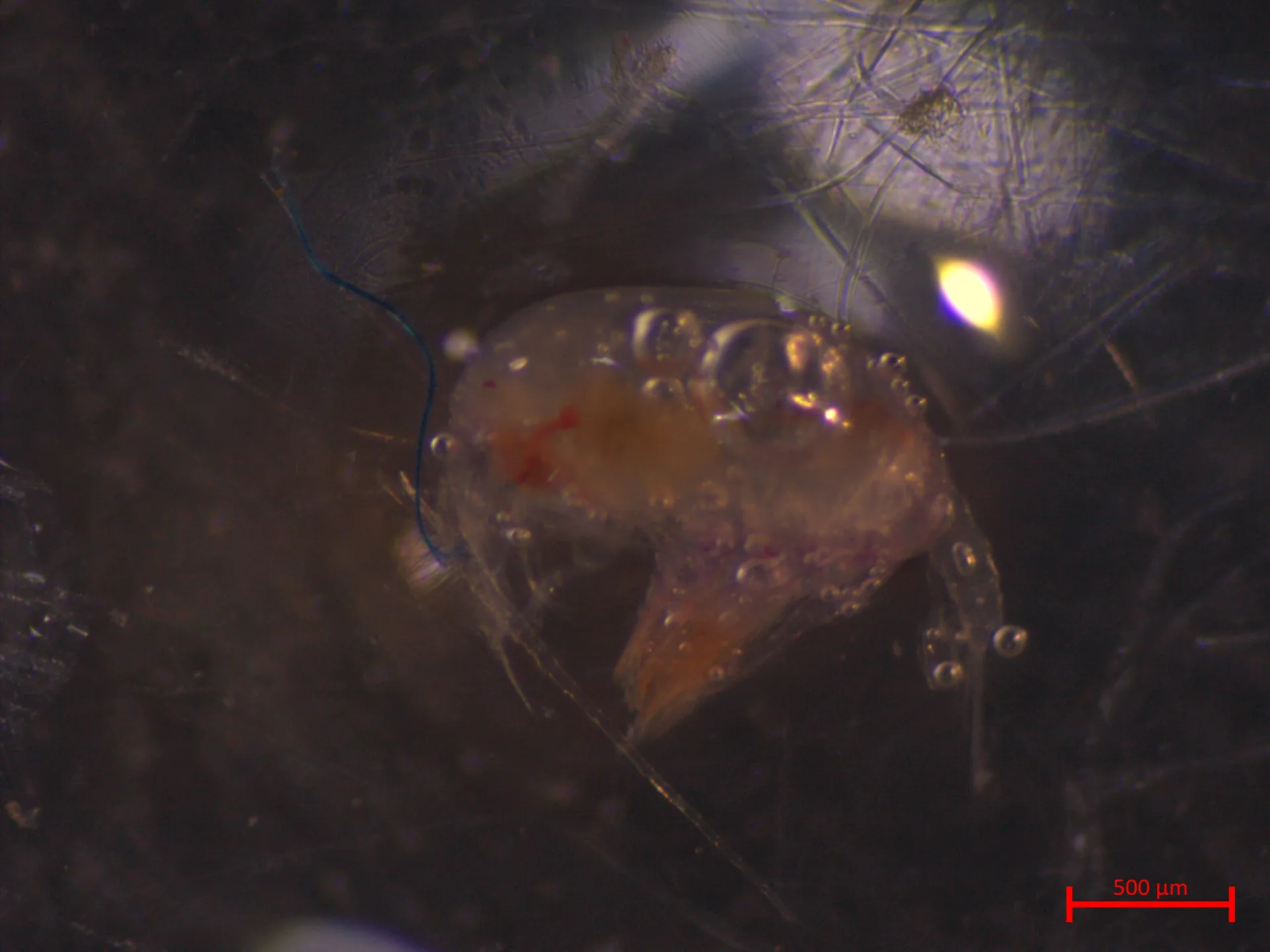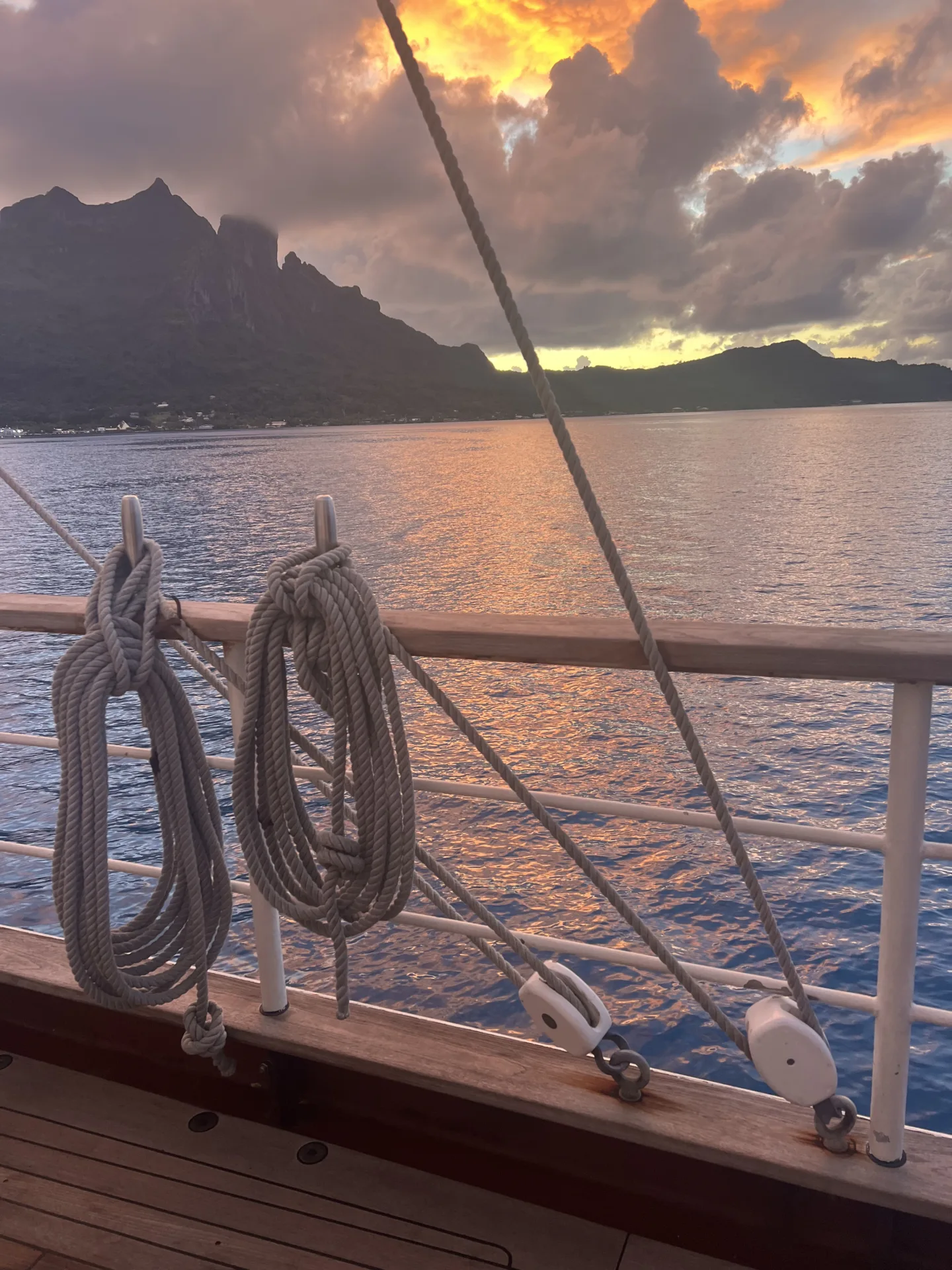News
Zooming In and Zooming Out: From Microplastics to Bora Bora

Date: May 9, 2025
Time: 1535
Location: Leaving Bora Bora – Raiatea here we come!
Weather: Wind out of the NE, Beaufort Force 2, cumulus and altocumulus clouds
Hello from beautiful Bora Bora! This final student blog for S321 comes to you with both bravery and ease from the charthouse housetop as we find ourselves anchored in a tropical paradise. Bravery because this is the first time the entire trip I’ve dared to bring my laptop on deck, and ease because writing this post is akin to writing a journal entry – familiar and stemming from immense contentment and gratitude.
As I currently watch my shipmates enthralled by “Squid TV” [watching squid over the side!] and occasionally steal a glance at the not-so-distant silhouette of Bora Bora just beyond the bow, I am tempted to continue typing about the here and now. However, I am going to briefly diverge and spend some words on a topic that I chose back in the early days of our program’s time in Woods Hole. Microplastics. Or more specifically, how and when do we measure microplastics and why should anyone care?
Microplastics are the silent killers of the plastic pollution world. The miniscule Mr. Hyde to the blatant Dr. Jekyll of plastic bags and straws that enrapture the masses. Nonetheless, “microplastic” is a word that strikes fear in the hearts of those who are familiar with the devilish polymers. From microplastics contained within the snow that falls on Everest to those buried at the bottom of the Mariana Trench, no corner of our planet is microplastic-free. A collection of scientists across multiple disciplines is even calling for plastics to infiltrate the official naming scheme of the geological time scale. The proposed “Plasticine Epoch” has a nice but somewhat sinister ring to it, don’t you think?
And while I’m at it, what are these microplastics? These microscopic menaces are anthropogenic particles smaller than 5mm in size (1). Generated during the production of commercial plastics and the decomposition of bigger plastics once commercial goods are introduced to the environment, microplastics pose major risks to marine organisms (2). Standing alone, microplastics are cause for major concern within marine food webs as microplastic ingestion starts at the zooplankton level and effectively works its way up marine food chains, ultimately resulting in bioaccumulation of microplastics that just might end up in your next ahi tuna poke bowl or seared swordfish steak. In contexts other than direct ingestion, microplastics floating through the water column can clog planktonic organisms’ respiratory, circulatory, and propellant systems.
As the name of our SEA program is Marine Biodiversity and Conservation, microplastics are an important constituent in the realm of conducting science to assess the current threats to the pelagic ecosystems that we have been sailing through and over the last five weeks. Sitting right up there with the heavyweight champions of open ocean anthropogenic issues (rising sea surface temperatures and ocean acidification), S321 has included microplastic detection in our everyday scientific operations. After neuston tows, plastic pieces larger than 2mm are separated from the sample and preserved. That leaves the microplastics. While data regarding microplastic presence is neither directly quantified nor directly utilized by any of the current student projects, all students have their eyes peeled for plastics when conducting 100 count processing. Here, plastics have been recorded piercing through clumps of forams [foraminifera], hanging off the tail end of copepods, and wrapped around the delicate gelatin that is a microscopic salp. For SEA cruises that do have a unique microplastic focus, data gained proudly contribute to the SEA microplastic database, which is one of the largest in the world and has the most thorough picture of macro and microplastic distribution in the South Pacific.
Zooming Out (But Not Too Far Out):
Leveling up in the plastic world are macroplastics, which are large enough to see with the naked eye. While we saw remarkably few adrift pieces of plastic trash in coastal New Zealand, the prevalence of floating plastic trash as we neared French Polynesia last week was our true first indicator that we were indeed coming back to civilization, save the few tropical birds that ventured out to meet us. Harrowing rescues of plastic bottles were made following science deployments once we had visuals of Tahiti and Mo’orea – Coca Cola was found to be the main offender.
All the Way Out:
Back to the here and now….
At the beginning of the S321 cruise component, I automatically fell subject to an age-old personal habit of mentally compartmentalizing future events so that I might always have something to look forward to and/or know what to expect. This consisted of thinking: “Okay, the first two weeks will be getting to know the lay of the land, the second two weeks will be that awkward middle “teenager” phase of existing in a new environment, and the last two weeks will be a memorable piece of cake.” However, as you probably know from reading other blog posts up until now, I am ecstatic to report that the final two weeks of our trip are contrary to what any of us (even my overthinking mind) could have expected. From surprisingly complex Junior Lab Officer and Junior Watch Officer shifts to a wonderful time in Bora Bora to the promise of our arrival in Raiatea on May 11th, our final two weeks are putting the pedal to the metal.
With my aforementioned habit of temporally organizing, I was under the self-misconstrued impression that these final two precious weeks would be full of endings. Thoughts such as “Oh, this is our second to last Saturday on the boat,” or “Aww our last watch meeting or watch will be at this time” filled my mind. However, as the universe and the Bobby C. would have it, myself and other students have spent some time in Bora Bora discussing how, as we come to a close in this phase of SEA, we have noticed ourselves perceiving more firsts than lasts; more notable beginnings than the feared grand finales.
My most notable first occurred on lookout on afternoon watch of May 5th. The sight I beheld was so beautiful I almost went back to the quarterdeck to report my joy to Jackie, but decided not to as my point of interest did not quite warrant abandoning my post. The object in question? LEAVES floating in the water! I had never been so excited to see those beautiful, chlorophyll-y products of plants that I take so for granted within the confines of my terrestrial life. Holding onto that joy of that first until I was no longer actively on lookout started the hamster wheels in my brain for how to approach this conclusion of my blog post….
Other notable firsts that have been expressed by many aboard the Robert C. Seamans – both students and crew – include, but are not limited to:
- Viewing our first sunset and sunrise over land/French Polynesia
- Firing up the DNA sequencer to analyze our hard-earned DNA goop!
- Touching land! This first was slightly ironic – we disembarked onto the asphalt dockside-road only to climb right back aboard after clearing customs out the back of a Papeete police van.
- B Watch’s first (and likely only) meter net deployment during evening watch, which yielded some characteristic twists and turns.
- Various bittersweet firsts on phones – maniacally checking summer housing and internship statuses, checking in on friends, and making brief calls to hear a family member’s voice for the first time.
As I close out this blog post as we actively motor away from the Bora Bora lagoon that we have been privileged enough to call our anchor spot for the last 48 hours, I reflect on the past five weeks and am comforted by the firsts that are to come… First steps on Mo’orea. First waves and hello hugs to none other than Elle Lansing. First run-throughs of final project presentations. And, last but not least, first opportunities for all of us to step away from SEA and bring all that we’ve experienced and learned back to our families, friends, and home institutions. –Olivia Hines, University of San Diego
Shoutouts:
To everyone following along in Reno, San Diego, and Delaware, you know I can often best express myself through music. I think that these song lyrics that have been running through my head during lookout rotations summarize my thoughts and feelings of ever-abundant gratitude and love for you all.
“You give me hope,
you give me reason.
It doesn’t help me if it’s something way too easy.
You said I changed,
and don’t I know it.
There’s time to think when all you’re staring at is ocean.”
Northwest Stories, “Stateroom with a View”
Further Reading:
1 Thompson, R.C., Olsen, Y., Mitchell, R.P., Davis, A., Rowland, S.J., John, A.W., McGonigle, D., Russell, A.E., 2004. “Lost at sea: where is all the plastic?” Science 304, 838-838.
2 Kumar, V., Umesh, M., Chakraborty, P., Sharma, P., Sarojini, S., Basheer, T., Kaur, K., Pasrija, R. Barcelo, D., 2023. “Origin, ecotoxicity, and analytical methods for microplastic detection in aquatic systems.” TrAC Trends in Analytical Chemistry, 117392.


